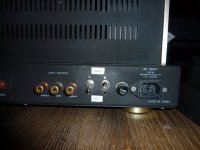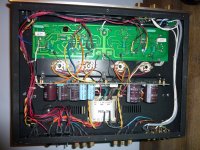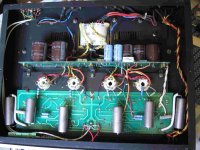I recently bought a used jolida 302b. I’m the third owner. I was told it has been modified but the last owner isn’t sure what was done to it. From searching this forum I read that there are quite a few mods for this amp. I was hoping someone could tell me the funtction of a couple switches that were added . I also noticed that an extra pair of RCA output jacks were added.
I’ve included some pictures of the outside of the amp to show switches and output jacks. Based on two little labels, I think the switches have to do with types of tubes. I can add an internal picture later.
I was told by the previous owner that the balance control had been bipassed and he didn’t know what the switches were for and just never used them.
I've never owned or heard a tube amp before so this is all new stuff to me.
I’ve included some pictures of the outside of the amp to show switches and output jacks. Based on two little labels, I think the switches have to do with types of tubes. I can add an internal picture later.
I was told by the previous owner that the balance control had been bipassed and he didn’t know what the switches were for and just never used them.
I've never owned or heard a tube amp before so this is all new stuff to me.
Attachments
I was hoping someone could tell me the funtction of a couple switches that were added .
Based on two little labels, I think the switches have to do with types of tubes.
might be different bias setting for using either EL34 or 6550 output
probably different cathode resistor
I've learned that this amp was modified at the factory. I emailed jolida the serial but haven't heard back yet.
It makes sense to me that the switches would be for different tubes. They should either both be up or down not one up and one down right? Sorry for the simple questions, i'm new to this stuff.
Where can i find a manual for the 302b? They are not posted on there website.
New pic of the inside.
It makes sense to me that the switches would be for different tubes. They should either both be up or down not one up and one down right? Sorry for the simple questions, i'm new to this stuff.
Where can i find a manual for the 302b? They are not posted on there website.
New pic of the inside.
Attachments
It makes sense to me that the switches would be for different tubes.
They should either both be up or down ?
no doubt about that
man, there sure is a long run of cables between board and them switches
that can't be good
but please don't touch anything unless you know exactly what you are doing
planet10,
I believe that there's an error on your schematic.
The instructions to convert to triode reads "Optional triode connection disconnect U/L tap from OPT (white & orange)".
On this schematic: http://drtube.com/schematics/jolida/sj-502a.gif and well as on both my 502's ("A" and "B" models) the UL taps are white and yellow.
If anyone wants to perform this mod they should double check the colors of the wires connected to pin 4 of the output tubes.
I believe that there's an error on your schematic.
The instructions to convert to triode reads "Optional triode connection disconnect U/L tap from OPT (white & orange)".
On this schematic: http://drtube.com/schematics/jolida/sj-502a.gif and well as on both my 502's ("A" and "B" models) the UL taps are white and yellow.
If anyone wants to perform this mod they should double check the colors of the wires connected to pin 4 of the output tubes.
The schema i posted is one done by Chris of his personal amp.
That's actually the older "SJ" schem. which doesn't show the PS changes for the JD302/502 series. The circuit is basically the same, other than the bias resistor/pot values. I'll post the 302b schem and an older pic of my amp showing the taped-off UL leads and green resistor connecting G2 & plate for triode operation.
Interesting that the OP's amp has a newer board with 502/F1 designation, whereas my amp has the older "SJ" board.
BTW, I've never seen an owners manual for this amp.
Attachments
I recently bought the 302b which I am told has been
modded to a 502b allowing the use of 6550 tubes
and being able to swap the tubes without the
need for rewiring, but just a bias change with the
adjustment through the access holes in the
chassis.
Mine, however has no switches other than the 3
front panel knobs and the ac on/off toggle.
I love this amp!
modded to a 502b allowing the use of 6550 tubes
and being able to swap the tubes without the
need for rewiring, but just a bias change with the
adjustment through the access holes in the
chassis.
Mine, however has no switches other than the 3
front panel knobs and the ac on/off toggle.
I love this amp!
302B op manual
Hi, new member and I need to find a copy of the basic ops manual for the above unit-not the schematic (already located that in this forum).
Many thanks,
FrSkip
Hi, new member and I need to find a copy of the basic ops manual for the above unit-not the schematic (already located that in this forum).
Many thanks,
FrSkip
Hi, new member and I need to find a copy of the basic ops manual for the above unit-not the schematic (already located that in this forum).
BTW, I've never seen an owners manual for this amp.
Not really that much to it, other than bias procedure.
jeff
Modifying my Jolida 302b amplifier
After reading numerous posts of others who have modified their Jolida 302b amplifiers (thank you everyone, with special thanks to Dave Ellis who's site on 302b mods is invaluable, and Jeff Golacky of SonicCraft who is beyond an expert and truly knows his stuff) I feel it's now my turn to submit my personal experience.
In 2002 I purchased a brand spanking new Jolida 302b from Galen Carol Audio for approximately $600 delivered to my door. How exciting it was to finally step across the threshold from the solid state world into the tube domain. I recall listening to my amplifier when it was new and feeling very satisfied with it's sound. Over the years, the sound has slowly and almost imperceptibly decayed into a much more flat, muddy and two dimensional sound. A few months ago a very dear friend of mine purchased a used Cary tube amplifier which is approximately 20 years old. Being an individual who loves nothing better than to make things better, he dove headlong into the wonderful world of capacitors and all things electrical. I marveled at his fearless approach to modifying his amplifier, and was astonished at what he did to his amp's sound simply by replacing the coupling capacitors. He then encouraged me to start working on my Jolida 302b, and slowly over time I was convinced that it was time to throw caution to the wind, set my fears of blowing my amp up aside, and dive down the rabbit hole. And so it began. The first step was finding Dave Ellis' site on the 302b which lays it out very clearly on how to approach the upgrade by replacing the essential parts needed for dramatically improved sound reproduction. The second step came after I went over to my friends home and listened to his upgraded Cary amp with nothing more than new Rike Audio S-cap coupling capacitors. It was a revelation the second I heard the new sound coming from his amp. Very impressive. I shortly thereafter ordered 4x .22uF and 2x .47 uF Rike Audio S-Caps and installed them with my friends help. This performance upgrade alone on the 302b exceeded my expectations and then some. I put a lot of weight on the magnificence of the Rike Audio S-Caps. A hidden gem in the world of coupling caps is all I will say. You must hear them for yourself and determine whether they are your cup of tea or not, but I am floored by their ability to seemingly do everything right. The third step involved calling Jeff Golacky at SonicCraft who was very generous with both his time and knowledge. After speaking with him, I decided it was time to replace all of the electrolytics with Panasonic TS-ED and ED series capacitors. Beyond that, I went with new Fairchild Superfast Diodes to replace the OEM diodes; I replaced the 4 OEM 1 ohm emitter cushion resistors with Mills resistors; then the OEM 1K ohm resistors were replaced with Takmans.
After installing this next batch of 'goodies' the Jolida 302b's sound quality was taken to the next level. Truly amazing things were happening to my 12+ year old Jolida. I then lived with this setup for a few weeks, marveling at how the sound was improving as everything settled in, most notably the Rike S-Caps. While all of this was going on, my friend with the Cary amplifier was beating the 'bypassing' drum and was thoroughly convinced that the next step to take was to bypass the electrolytic capacitors related to the power supply. He suggested I look into the JFX capacitor line as the size of the caps is small relative to other offerings and the price is right. On my own initiative and research, I opted to bypass the main 450v/470uF power caps with a series of caps laddered in parallel loosely based on the rule of 10ths. I utilized a 4.7uf, coupled with at .47uf, coupled with a .047uf, and finally a .0047uf. I soldered the smallest value closest to the leads of the power caps, and continued on until the largest value finished the ladder. There is a school of thought that supports this approach and I can whole heartedly say that the sonic result of this 'bypassing' upgrade was significant. To be honest, I was skeptical of 'bypassing' and how it blackens the background; allows for better separation of the instruments; gives better low end control and more articulate highs. But my skepticism quickly dissipated on the first note that came out of the Jolida after the bypass. Very nice indeed. And so I listened to this setup for a few weeks and decided to bypass the remaining electrolytics using the same laddered bypass approach, and once again, another improvement in a blacker background, improved separation, and better low end control and more articulate highs.
At this point, I believe I will set down the soldering iron and enjoy the music. It's been quite the journey and I feel very grateful for taking it. For those of you who have a 302b (especially an older one like mine) and are considering doing this upgrade, I feel more than confident in telling you that the gains in sound improvement are well worth it.
After reading numerous posts of others who have modified their Jolida 302b amplifiers (thank you everyone, with special thanks to Dave Ellis who's site on 302b mods is invaluable, and Jeff Golacky of SonicCraft who is beyond an expert and truly knows his stuff) I feel it's now my turn to submit my personal experience.
In 2002 I purchased a brand spanking new Jolida 302b from Galen Carol Audio for approximately $600 delivered to my door. How exciting it was to finally step across the threshold from the solid state world into the tube domain. I recall listening to my amplifier when it was new and feeling very satisfied with it's sound. Over the years, the sound has slowly and almost imperceptibly decayed into a much more flat, muddy and two dimensional sound. A few months ago a very dear friend of mine purchased a used Cary tube amplifier which is approximately 20 years old. Being an individual who loves nothing better than to make things better, he dove headlong into the wonderful world of capacitors and all things electrical. I marveled at his fearless approach to modifying his amplifier, and was astonished at what he did to his amp's sound simply by replacing the coupling capacitors. He then encouraged me to start working on my Jolida 302b, and slowly over time I was convinced that it was time to throw caution to the wind, set my fears of blowing my amp up aside, and dive down the rabbit hole. And so it began. The first step was finding Dave Ellis' site on the 302b which lays it out very clearly on how to approach the upgrade by replacing the essential parts needed for dramatically improved sound reproduction. The second step came after I went over to my friends home and listened to his upgraded Cary amp with nothing more than new Rike Audio S-cap coupling capacitors. It was a revelation the second I heard the new sound coming from his amp. Very impressive. I shortly thereafter ordered 4x .22uF and 2x .47 uF Rike Audio S-Caps and installed them with my friends help. This performance upgrade alone on the 302b exceeded my expectations and then some. I put a lot of weight on the magnificence of the Rike Audio S-Caps. A hidden gem in the world of coupling caps is all I will say. You must hear them for yourself and determine whether they are your cup of tea or not, but I am floored by their ability to seemingly do everything right. The third step involved calling Jeff Golacky at SonicCraft who was very generous with both his time and knowledge. After speaking with him, I decided it was time to replace all of the electrolytics with Panasonic TS-ED and ED series capacitors. Beyond that, I went with new Fairchild Superfast Diodes to replace the OEM diodes; I replaced the 4 OEM 1 ohm emitter cushion resistors with Mills resistors; then the OEM 1K ohm resistors were replaced with Takmans.
After installing this next batch of 'goodies' the Jolida 302b's sound quality was taken to the next level. Truly amazing things were happening to my 12+ year old Jolida. I then lived with this setup for a few weeks, marveling at how the sound was improving as everything settled in, most notably the Rike S-Caps. While all of this was going on, my friend with the Cary amplifier was beating the 'bypassing' drum and was thoroughly convinced that the next step to take was to bypass the electrolytic capacitors related to the power supply. He suggested I look into the JFX capacitor line as the size of the caps is small relative to other offerings and the price is right. On my own initiative and research, I opted to bypass the main 450v/470uF power caps with a series of caps laddered in parallel loosely based on the rule of 10ths. I utilized a 4.7uf, coupled with at .47uf, coupled with a .047uf, and finally a .0047uf. I soldered the smallest value closest to the leads of the power caps, and continued on until the largest value finished the ladder. There is a school of thought that supports this approach and I can whole heartedly say that the sonic result of this 'bypassing' upgrade was significant. To be honest, I was skeptical of 'bypassing' and how it blackens the background; allows for better separation of the instruments; gives better low end control and more articulate highs. But my skepticism quickly dissipated on the first note that came out of the Jolida after the bypass. Very nice indeed. And so I listened to this setup for a few weeks and decided to bypass the remaining electrolytics using the same laddered bypass approach, and once again, another improvement in a blacker background, improved separation, and better low end control and more articulate highs.
At this point, I believe I will set down the soldering iron and enjoy the music. It's been quite the journey and I feel very grateful for taking it. For those of you who have a 302b (especially an older one like mine) and are considering doing this upgrade, I feel more than confident in telling you that the gains in sound improvement are well worth it.
- Status
- Not open for further replies.
- Home
- Amplifiers
- Tubes / Valves
- New Jolida 302b amp owner questions



